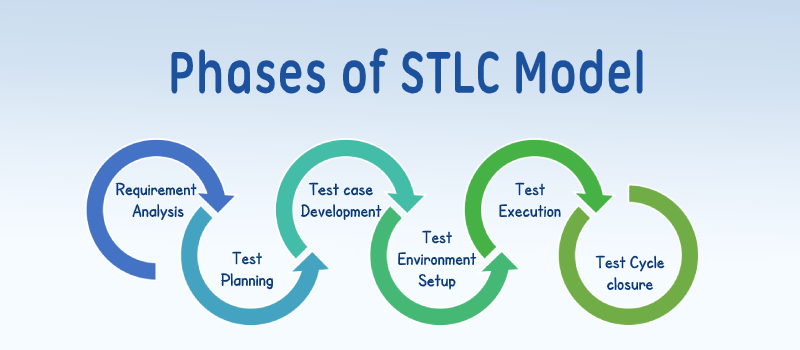Mastering Software Testing: Techniques and Approaches
Introduction to STLC (Software Testing Life Cycle)

Introduction
The Software Testing Life Cycle (STLC) is a set of precise steps taken throughout the testing process to guarantee that the software quality goals are attained. Validation and verification are both included in the STLC. Contrary to common belief, testing software is not a standalone task. It is made up of a number of methodical tasks that will aid in certifying your program. The Software Development Life Cycle (SDLC), a framework with six guiding principles, is a framework that includes the STLC, a high-quality strategy that is directly related to and a component of it.
- Requirements analysis
- Planning
- Engineering and design
- Software development
- Testing
- Deployment
The SDLC may be thought of as a cycle where decisions made at one level are mirrored in other phases. The STLC has phases as well, and the fifth stage, which I'll discuss below, is where it most nearly resembles the SDLC.
What to use the STLC for
We may infer that STLC contains a number of stages, including planning, control, implementation, standardization, and so forth, since we can define it as a collection of testing measures. All of this points to the necessity of the STLC for the following purposes, in addition to testing the generated product:
- Resolving its problems at the most beneficial time in its growth
- Enhancing the development process's transparency and quality
- Maximizing control over the product's quality at every phase of the SDLC
- figuring out how the usage of the testing life cycle is affected by the deployment of SAFe, Scrum, Agile etc. providing a superb product to the client and the consumers.
The role of the STLC in the SDLC
As was already established, the STLC & SDLC are closely connected, but they also work toward the same objectives in distinct ways, namely:
Analyzing requirements, supporting the client and the development team, and validating the quality of the implemented functionality are all steps in the SDLC that include gathering needs in the desired form and implementing the declared capability (as for the STLC).
During the majority of the project, the SDLC and STLC lines work in parallel, but they start to quickly converge during the process of software development and achieve deep synchronization during the SDLC Test phase. This graph holds true for the execution of a job inside a project and reverses for a project with a high number of iterations. It is applicable to many different sorts of projects, not simply big or independent ones.
Six Phases of STLC
The STLC system is often nearly identical to the SDLC system and comprises numerous related phases. These consecutive stages are known as: Let's examine each of them more closely.
1. Requirement Analysis
One of the most crucial stages is requirements analysis since this is the time when project problems may be fixed nearly entirely without cost. In addition to identifying the possible need for automated testing, the requirements analysis phase also enables economic labor cost projections based on project estimation. The Entry & Exit Criteria are also addressed and written down at this time.
Software testing requires entry and exit criteria at every stage of the STLC. Exit Criteria specify the conditions that must be completed before you can finish the testing, whereas Entry Criteria specify the requirements for beginning it. In a perfect world, you wouldn't go on to the next testing phase unless all of the exit criteria for the prior one were satisfied.
2. Test Planning
A test plan is created during this stage. This is the actualization of all testing phases, including time, participants, and roles. As a result, we obtain information on:
- Test subjects and their responsibilities
- Required test instruments
- Required test environment
3. Test Case Development
To fully cover the functioning and features of the program, test development entails employing both human and automated testing, with the process being dependent on the requirements established beforehand. Since the test cases for human testing are typically documented in the form of cheat sheets, it is common practice to write the test cases used for testing automation separately. Every test case has a unique life cycle that includes creation, verification, and revision.
4. Test Environment Setup
Which test environment has to be employed is made explicit in the test plan. Operating systems, virtual machines, Selenium, Katalon Studio, the project's test environment, and databases are all deployed during this STLC phase. If assistance is required, we also send requests to DevOps and Admins.
5. Test Execution
On the basis of primed documentation and a properly set up test environment, tests are run. All test results are recorded by the test management system. Negatively passed tests—those in which the outcome is different from what was anticipated—are noted as mistakes and forwarded to the project team for script amendment and subsequent rechecking after rectification.
6. Test Cycle Closure
The final creation of testing reports for the customer is the STLC's last step. These have to contain the amount of time used, the ratio of discovered flaws to successful test outcomes, and the overall number of faults discovered and corrected. For the testing department, this is the time to evaluate its work, compile the findings, assess its productivity, and have the chance to offer ideas for raising the caliber of testing.
Conclusion
Given our understanding of the STLC in software testing and its purpose, we can predict exactly how the graph of interactions between the STLC & SDLC would appear.
